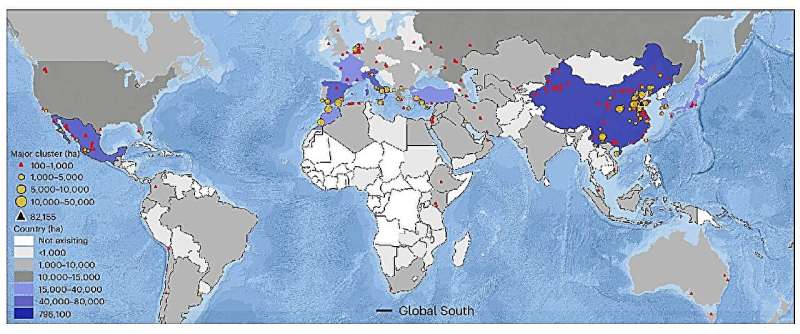This article has been reviewed according to Science X's editorial process and policies. Editors have highlighted the following attributes while ensuring the content's credibility:
fact-checked
peer-reviewed publication
trusted source
proofread
Satellite mapping reveals a global bloom in greenhouse cultivation

We have long become accustomed to enjoying tomatoes, cucumbers, berries and melons year-round. In Europe, most of these imports come from Spain, where millions of tons of fruit and vegetables are grown under seas of white plastic that span the southern part of the country.
Globally, greenhouse cultivation is increasing rapidly, according to a new study from the University of Copenhagen that maps the global extent of greenhouses. But the majority of this boom is happening outside of Europe, it is taking place in low- and middle-income countries in the Global South.
Using a combination of deep learning algorithms and modern sources of satellite imagery, the researchers mapped the amount of land used for greenhouse cultivation worldwide. Their mapping shows that greenhouse cultivation—whether it takes place in glass houses or open fields wrapped in plastic films—covers at least 1.3 million hectares of the Earth's surface. The new figure is nearly three times more than previous estimates.
China in first place, by far
Greenhouse cultivation is spread over 119 different countries, of which China accounts for an entire 60.4% of the total area. Spain and Italy occupy second and third place with 5.6% and 4.1% of global greenhouse coverage respectively.
Whereas large clusters of greenhouses in the Global North were established in the 1970s and 1980s, they began to spring up in the Global South two decades later. And while there has been some stagnation in the Global North, the trajectory of growth continues in Asia, Africa and Central and South America. Indeed, greenhouses in the Global South account for 2.7 times as much area as in the Global North.
"Greenhouse cultivation has become a global phenomenon and there is every indication that it will continue to expand. Until now, however, this phenomenon is rapidly rising under the radar and we have had large gaps in our knowledge of the dynamics that drive this phenomenon," says Xiaoye Tong, a postdoc at the Department of Geosciences and Natural Resource Management and first author of the research article published in Nature Food.
According to the researchers, China's dominance in terms of area is probably tied to the country's socio-economic development. Here, the study also found that large clusters of greenhouses are located near metropolitan areas.
"The boom in China seems to be closely linked to its strong economic performance over the past decade and the rise of an urban population with purchasing power that demands tomatoes, cucumbers and other types of fresh fruit and vegetables.
"At the same time, farmers who would otherwise be unable to finance this form of cultivation receive government subsidies and support to build greenhouses and learn cultivation techniques," says Xiaoye Tong.
Huge benefits, as well as consequences
Government support for greenhouse growers doesn't just exist in China—it is found in arid and semi-arid regions that have traditionally not been cultivated or seen intensive agriculture before. Indeed, half of all areas with greenhouse cultivation are located in regions with major resource limitations, such as water scarcity. As such, the researchers point out that greenhouse cultivation provides opportunities for local food security and the alleviation of poverty in the Global South.
Due to their controlled environments, greenhouses potentially offer a range of major advantages in the form of higher and more stable yields, efficient irrigation systems, the more precise dosing of fertilizers and nutrients, and an improved control of crop quality.
But there is a flip side to the coin as well—and we need to better understand it, argues associate professor and co-author Marianne Nylandsted Larsen from the Department of Geosciences and Natural Resource Management.
"We know very little about the environmental and social consequences of greenhouse cultivation in the Global South. But we do know that these can include the overexploitation of water resources, high energy consumption, the contamination of groundwater with pesticides and fertilizers, soil degradation and plastic pollution from greenhouses that make use of plastic film and sheeting. Furthermore, agricultural working conditions have often been criticized," says Larsen.
Consequently, the researchers believe that political regulation of the sector needs to be considered.
"In low- and middle-income countries, which account for 70%–80% of the total area, there is a lack of regulation in greenhouse cultivation. This needs to be addressed," says Xiaoye Tong.
At the same time, there is a need for more research into the importance of greenhouse cultivation for countries in the Global South, concludes Larsen. "I hope this mapping serves as a point of departure for studies related to the consequences of greenhouse cultivation. For example, has it alleviated rural poverty? Does greenhouse cultivation affect the demand and quality requirements for fruit and vegetables in both national and international markets?
"And what consequences does this have on the consumption of groundwater resources, fertilizers and chemicals? These types of questions are important to answer if we are to ensure sustainable and socially responsible development within the sector."
More information: Xiaoye Tong et al, Global area boom for greenhouse cultivation revealed by satellite mapping, Nature Food (2024). DOI: 10.1038/s43016-024-00985-0
Journal information: Nature Food
Provided by University of Copenhagen





















